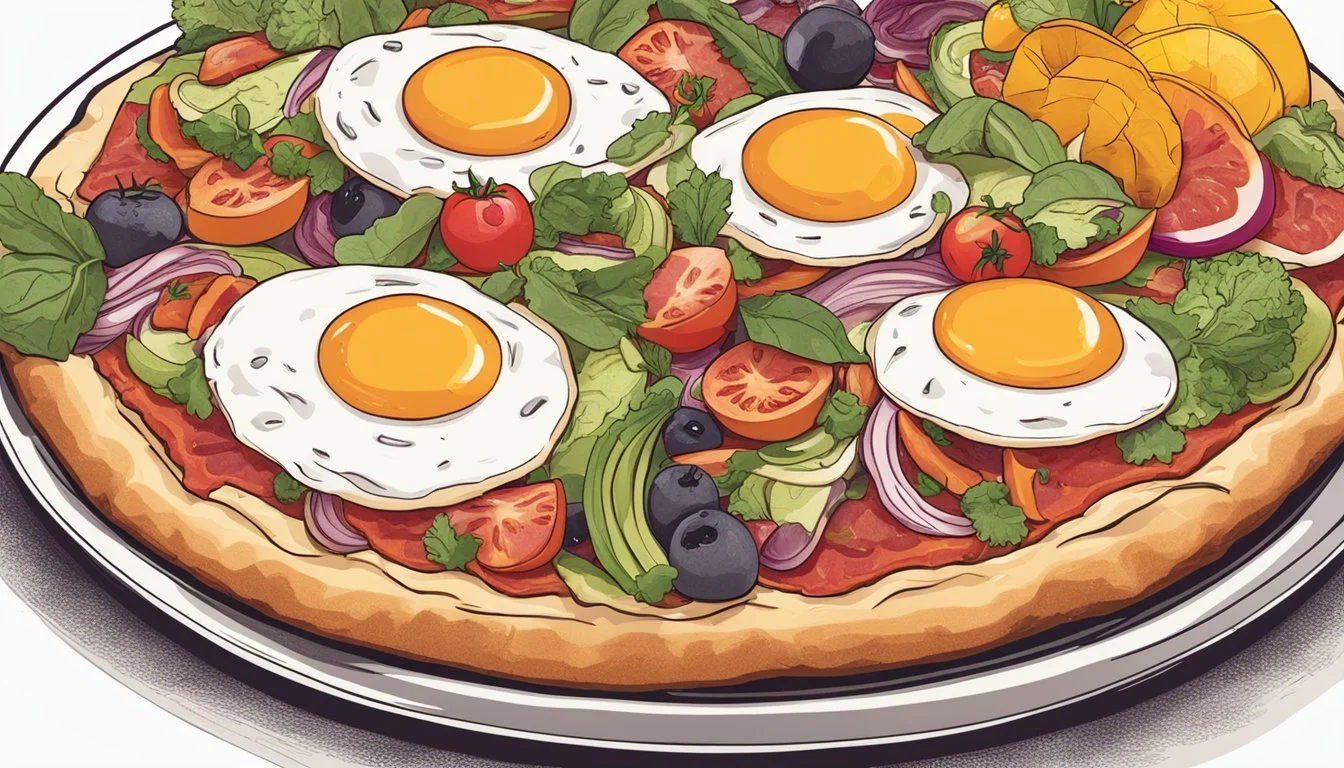Is Bacon and Egg Pizza Vegan?
Debunking Common Food Myths
The concept of bacon and egg pizza (What wine goes well with pizza?) presents a culinary juxtaposition when approached from a vegan perspective. Typically, pizza is a dish defined by its versatile nature, allowing for an array of toppings to suit myriad dietary preferences and restrictions. In its traditional form, bacon and egg pizza is decidedly not vegan, as it features animal-derived products – both the bacon, which is cured pork, and the eggs. Vegans abstain from consuming all animal products, which includes meat, dairy, and eggs, making the classic bacon and egg toppings incompatible with a vegan diet.
However, the rise of plant-based diets has prompted an evolution in pizza-making. Now, vegan alternatives to popular pizza toppings, (What wine goes well with pizza toppings?) including bacon and eggs, are readily available. These vegan versions are crafted from a variety of plant-based ingredients like tofu, tempeh, or textured vegetable protein to emulate the taste and texture of bacon, and from tofu, potato starch, or specific vegan egg replacement products to create a substitute for eggs. Vegan pizzas thus reimagine traditional favorites using these ingredients, allowing those following a vegan lifestyle to enjoy similar flavors without compromising their dietary principles.
A pizza can only be considered vegan if every ingredient, from the dough to the toppings and sauces, contains no animal products. Therefore, the availability of creative plant-based alternatives to bacon and eggs gives rise to the possibility of a vegan bacon and egg pizza. This innovation caters to the growing demand for inclusive food options that honor the essence of beloved dishes while adhering to vegan standards.
Understanding Veganism
Making a conscious choice about what one eats is at the core of veganism, which advocates for a diet free from animal products, focusing on plant-based alternatives for nutrition and ethical consumption.
Define Vegan Diet
A vegan diet consists entirely of plant-derived foods. It excludes all animal products, which means no meat, dairy, eggs, or honey. Those who follow a vegan diet often seek meat alternatives such as tofu, seitan, (What wine goes well with seitan?) or tempeh, and dairy free options like almond milk, soy milk, and coconut yogurt. A plant-based approach emphasizes whole, minimally processed foods, which aligns with the vegan emphasis on egg free and dairy free choices.
Meat and fish: Not consumed. Alternatives include legumes, tofu, and plant-based meats.
Eggs: Avoided. Flax or chia seeds often serve as substitutes.
Dairy: Omitted. Plant milks and vegan cheeses are common replacements.
Why Veganism Matters
Veganism extends beyond diet; it is a lifestyle choice driven by various factors:
Health: Advocates suggest that a plant-based diet can lead to lower rates of certain diseases.
Environment: Plant-based diets typically require less water and land, and result in lower carbon emissions.
Ethical reasons: Avoiding animal products can be seen as taking a stand against animal exploitation and cruelty.
It's the interplay between personal health, environmental sustainability, and animal welfare that informs the vegan decision-making process.
Components of Traditional Pizza
Traditional pizza constitutes a classic culinary craft involving specific ingredients and methods of preparation. This section dissects the essential makeup of conventional pizza styles.
Crucial Elements of Pizza
Traditional pizza dough forms the foundation of any pizza recipe. It typically consists of flour, water, yeast, salt, and sometimes oil. This mixture is kneaded until smooth, proving until doubled in size, which creates the base known as the pizza crust. After rolling out, it serves as the canvas for the toppings.
Sauce is the next critical layer, often a rich tomato sauce, seasoned with herbs like basil and oregano for added flavor. However, sauces can vary, with some recipes calling for white sauce, pesto, or even a simple garlic and olive oil glaze.
Cheese is integral, with mozzarella being the predominant choice due to its excellent melting properties and mild taste. Other cheese varieties can be used either alone or in combination with mozzarella for different flavor profiles.
Common Pizza Toppings
Meats: pepperoni, sausage, ham, bacon
Vegetables: onions, bell peppers, mushrooms, olives
Others: anchovies, (What wine goes well with anchovies?) pineapple, various cheeses
While the above list is not exhaustive, these items represent the more common toppings diners expect on pizzas.
Culinary Significance of Pizza
Pizza’s versatility and adaptability have solidified its status in the culinary world. It's not just food but a platform for a multitude of flavors and textures, accommodating a vast range of dietary preferences and traditions. The choice of ingredients and their quality directly influence the taste and authenticity of the pizza, allowing it to range from a simple Margherita to a hearty meat lovers' delight.
Bacon and Egg Pizza Breakdown
In the culinary world, bacon and eggs hold a significant place, particularly in breakfast dishes. Their nutritional profile and distinct flavors contribute to their popularity as ingredients for various meals, including the beloved breakfast pizza.
Bacon in Cuisine
Bacon, known for its rich and savory flavor, is a common topping for breakfast pizzas. It provides a satisfying crunch and a salty flavor that pairs well with other ingredients such as cheese and pepper. Traditionally, bacon is made from pork, but alternatives like turkey bacon and tofu bacon offer dietary variation without sacrificing the distinctive bacon taste.
Nutritional aspect: Bacon is high in protein and fat, and while it adds flavor, it should be consumed in moderation due to its high sodium and saturated fat content.
Cooking bacon for pizza: For a crispy texture, it's often fried before being added to pizza as a topping.
Eggs as Ingredients
Eggs are a staple in breakfast meals and serve as a key element for breakfast pizzas. They can be incorporated directly onto the pizza, either cracked whole or scrambled.
Cooking times: Depending on the desired doneness, eggs may be cooked for 10-12 minutes for a softer yolk or up to 15 minutes for a fully set yolk, when baked on a pizza.
Nutritional contribution: Eggs are a source of high-quality protein and other essential nutrients, making them a valuable addition to the meal.
Combining with other ingredients: Garlic can be added to enhance the flavor profile, while pepper and cheese are often incorporated for an extra kick and richness, respectively.
Utilizing bacon and eggs on a pizza creates a dish that is not only tasty but also packed with proteins and other nutrients, though it's important to balance with other food groups for a rounded diet. ItaliaIn the context of a vegan diet, however, traditional bacon and eggs would be substituted with plant-based alternatives to align with the dietary restrictions.
Transitioning to Vegan Pizza
Transitioning to a vegan lifestyle often involves finding plant-based alternatives for familiar favorites like bacon and egg pizza. Understanding the substitutes and crafting an entirely vegan pizza, from crust to toppings, is essential for a satisfying culinary experience.
Finding Substitutes for Bacon and Eggs
When creating a vegan version of bacon and egg pizza, one must select appropriate alternatives that mimic the flavors and textures of the original ingredients. Vegan bacon can be made from a variety of plant-based sources, including tempeh, coconut, mushrooms, or soy protein. These substitutions aim to replicate the smoky, salty taste associated with traditional bacon. Tofu scramble serves as an excellent egg replacement, providing a similar texture and protein content. Turmeric can be added to the tofu scramble to achieve the yellow hue commonly associated with scrambled eggs.
Vegan Toppings and Add-ons
A diverse selection of toppings is key to enhancing the flavor profile of any vegan breakfast pizza. Traditional toppings such as tomatoes, olives, peppers, mushrooms, and onions are naturally vegan and add freshness and complexity to the pizza. For a heartier option, vegan sausage or plant-based meat alternatives can add depth and satisfy cravings for former meat feast fans. Vegan cheese, made from nuts, soy, or other dairy-free options, can be sprinkled on top to provide the creamy, melty consistency pizza lovers expect.
Crafting Vegan Pizza Dough and Crust
The foundation of any pizza is its crust. Vegan pizza dough is made without any animal products, ensuring that it is suitable for vegan diets. Basic ingredients include flour, water, yeast, salt, and sometimes sugar and olive oil for richness. It's important to verify that the dough is free from dairy products or eggs, which are sometimes found in pre-made crusts. A simple, homemade dough is not only vegan but also allows for customization in thickness and texture, facilitating a truly personalized pizza experience.
Preparation and Cooking Guide
Crafting a savory vegan bacon and egg pizza calls for meticulous preparation and precise baking techniques. With the right combination of ingredients and cooking methods, one can create a delightful plant-based version of this classic breakfast pizza.
Step-by-Step Vegan Pizza Recipe
Ingredients:
For the dough:
2 1/2 cups all-purpose flour or gluten-free alternative
1 cup warm water
1 tsp sugar
1 packet active dry yeast
1 tbsp olive oil
1/2 tsp salt
Toppings:
1/4 cup olive oil for brushing
1/2 cup vegan cheese shreds
Vegan bacon, cooked and chopped
Vegan egg substitute
2 cloves garlic, minced
Additional toppings: tomatoes, spinach, or mushrooms
Prep Time: 15 minutes + 1 hour for dough rise Cook Time: 10-15 minutes Servings: 2-3
Preparing the Dough: Combine the warm water, sugar, and yeast in a bowl, letting it sit until frothy (about 5 minutes). Mix in the olive oil, flour, and salt until a dough forms. Knead on a floured surface until smooth. Place in a greased bowl, cover, and let it rise for 1 hour.
Prepping the Toppings: Sauté the vegan bacon until crispy, then set it aside. Cook vegan egg substitute per its instructions until it resembles scrambled eggs. Prepare any additional vegetables by sautéing until tender.
Assembling the Pizza: Preheat the oven with a pizza stone inside to 450ºF (232ºC). Roll out the risen dough on parchment paper to the desired thickness. Brush with olive oil and top with minced garlic, vegan cheese, and prepared toppings.
Baking Techniques for Perfect Vegan Pizza
Baking:
Using a Pizza Stone: Preheat the stone with the oven to ensure a crisp crust. Transfer the assembled pizza—on the parchment paper—onto the stone for baking.
Cooking Time: Cook the pizza in the preheated oven for about 10-15 minutes or until the crust is golden and vegan cheese is melted.
Broiling (Optional): For an extra crispy top, broil the pizza for the final 2 minutes. Watch closely to prevent burning.
Resting: Let the pizza cool slightly on a wire rack before slicing and serving to allow the toppings to set.
By applying these focused tips, one can achieve a vegan bacon and egg pizza that boasts a crispy crust, melty cheese, and rich, satisfying flavors.
Nutritional Profile of Vegan Breakfast Pizza
The nutritional profile of a vegan breakfast pizza can vary widely, but commonly includes ingredients like tofu and assorted veggies, offering a balance of macronutrients and essential micronutrients. When assessing the nutritional content, one must consider both the caloric content and the balance of macros and micros.
Assessing Caloric Content
The caloric content of vegan breakfast pizza is primarily determined by its crust, toppings, and the amounts used. A base made with whole grain flour may contain more nutrients and fiber, leading to greater satiety. Toppings typically include tofu as a protein replacement for eggs and various vegetables such as spinach, which are low in calories and high in nutritional value. Nutritional yeast, a common cheese substitute, adds flavor and vitamins with minimal calories. A slice of vegan breakfast pizza can roughly range from 200 to 300 calories, with variations depending on the size and exact ingredients used.
Macro and Micronutrients Distribution
Macronutrients in a vegan breakfast pizza are well-distributed across carbohydrates, proteins, and fats. The crust provides carbohydrates, while firm tofu—a staple protein source in such pizzas—contributes a significant amount of protein. Tofu's protein content complements that of nutritional yeast, which is not only rich in protein but also in B-vitamins.
Micronutrients can be quite diverse on a vegan breakfast pizza. Spinach and other veggies contribute a variety of vitamins, minerals, and fiber. Spinach, for example, is a rich source of iron and calcium. The use of black salt, or kala namak, not only adds an egg-like flavor but also provides trace minerals not commonly found in other salts.
In table format, a general breakdown might look like this:
Ingredient Macronutrients Key Micronutrients Whole grain crust High in carbohydrates Fiber, B-vitamins Firm tofu High in protein Iron, Calcium Nutritional yeast Protein and fats B-vitamins Spinach Low macronutrients Iron, Calcium, Vit A Assorted veggies Varied carbohydrates Assorted vitamins
It should be noted that preparing a vegan breakfast pizza with whole food ingredients can maximize nutritional benefits while keeping processed additives to a minimum.
Enhancing Vegan Pizza Flavors
In the world of vegan pizza, utilizing a broad spectrum of seasonings and expertly building layered flavor profiles can turn a simple pizza into a culinary delight. Attention to these components proves essential for achieving a rich and satisfying taste.
Exploring Seasonings and Spices
Olive oil and garlic take center stage in vegan pizza flavor enhancement. Drizzled over the top or integrated into sauces, they provide a robust base that enhances other ingredients. Onion and garlic powder offer additional layers of flavor without the moisture of their fresh counterparts, making them ideal for a concentrated taste. Moving to the spice rack, black pepper, red pepper flakes, smoked paprika and cayenne lend a heat profile that can be adjusted according to preference. Even a pinch can greatly amplify depth. Turmeric enters as an unconventional but splendid addition, imparting an earthy tone and health benefits along with its vibrant color.
Key Seasonings for Vegan Pizza:
Olive oil
Garlic (fresh or powder)
Black pepper and red pepper flakes for heat
Onion (fresh or powder)
Turmeric for color and flavor
Constructing Layered Flavor Profiles
Building flavors on a vegan pizza involves considering each component's profile and how they interact. Tomatoes, whether fresh like cherry tomatoes or in sauce form, provide a tangy acidity that is fundamental to many pizza varieties. Red bell peppers and kale introduce a sweet and earthy contrast, with both offering different textures. The key is to balance these flavors with spices like paprika which contributes a subtle warmth, and sea salt, which should be sprinkled judiciously to enhance overall taste without overpowering the delicate flavors of the vegetables. For an illusion of meatiness, like pepperoni, one could experiment with marinating ingredients such as tofu or tempeh in a mixture of soy sauce, olive oil, smoked paprika, and a touch of cayenne.
Techniques for Layered Flavors:
Use ripe tomatoes or a robust tomato sauce as the base layer.
Combine sweet veggies like red bell pepper with earthy greens like kale.
Marinate protein substitutes in spices for depth (like pepperoni flavors).
Balance with the right amount of sea salt and aromatic spices.
Accompaniments and Serving Suggestions
When serving a vegan bacon and egg pizza, one can enhance the dining experience by selecting appropriate side dishes and using creative presentation techniques. These can complement the flavors and add to the visual appeal of the meal.
Complementary Dishes for Vegan Pizza
For those hosting a brunch (What wine goes well with brunch?) or breakfast gathering, the addition of complementary dishes can turn a simple pizza into a feast. Here are some specific vegan dishes that pair well with the pizza:
Vegan Breakfast Sausage: The savory flavors of vegan sausage beautifully complement the smokiness of vegan bacon bits on the pizza.
Breakfast Tacos: Offering a side of breakfast tacos filled with seasoned tofu scramble and fresh vegetables can provide variety.
Salad: A simple arugula salad with a lemon vinaigrette dressing can add a fresh, peppery contrast to the hearty pizza.
Wrap: Consider preparing a breakfast wrap filled with beans, mushrooms, and avocado for a handheld option.
For leftovers, consider repurposing the pizza toppings into a breakfast sandwich for a satisfying next-day meal.
Presentation and Serving Ideas
The presentation of vegan bacon and egg pizza should be both appealing and functional. Here are specific ideas for serving:
Individual Slices: Cut the pizza into individual slices for easy sharing and a casual dining experience.
Platter Display: Arrange the pizza slices on a large platter surrounded by the accompaniments for a visually engaging spread.
Herb Garnish: Sprinkle with chopped fresh herbs such as parsley or chives to add color and enhance flavor.
Ensuring the pizza is served hot is crucial for maximum enjoyment, as it allows the vegan cheese to remain melty and the vegan bacon to stay crisp.
Lifestyle and Dietary Considerations
When examining the compatibility of bacon and egg pizza with veganism, it becomes evident that such a dish in its conventional form contradicts the strict plant-based ethos vegans adhere to. Below, key aspects of a vegan lifestyle and considerations for health and taste in context with vegan-friendly pizza alternatives are explored.
Living as a Vegan
Individuals who embrace a vegan lifestyle abstain from all animal products. This means that traditional bacon and eggs are off the menu since they originate from animals. Instead, those living as vegans seek out plant-based substitutes. For a pizza topping akin to bacon, they might opt for plant-based meat alternatives, like soy-based or seitan bacon, which mimic the flavor and texture without using animal products. Egg replacements could include tofu scrambles seasoned with nutritional yeast for a cheesy flavor and fortified with vitamins, such as B12, to align with their dietary practices.
Vegan "Bacon" Toppings:
Soy-based bacon
Seitan bacon
Nutritional yeast (for flavor)
Balancing Taste and Health
Vegans often seek a balance between satisfying taste and maintaining health. For a bacon and egg pizza, alternatives include vegetables like mushrooms, which provide a meaty texture, and vegetables known for their robust flavor profiles, such as onions and peppers. It's also essential for those on a vegan diet to ensure they get a wide range of nutrients. For a healthier base, a gluten-free crust may be ideal for those with specific dietary needs, while various toppings can offer not only diverse flavors but also essential vitamins and minerals.
Healthful Crust Options:
Whole grain crust
Gluten-free crust
Nutrient-Rich Toppings:
Mushrooms (selenium, potassium)
Red peppers (vitamin C)
Olives (healthy fats)
Cashew cheese
Almond cheese
By leveraging the abundant alternatives available, vegans can enjoy a bacon and egg pizza that aligns with their lifestyle and dietary considerations, proving that flavor need not be sacrificed for principle.
Innovative Vegan Pizza Variations
Exploring the realm of innovative vegan pizza variations reveals a world where traditional flavors are reimagined with plant-based ingredients. The creativity in these recipes honors both taste and ethical eating choices.
Examples of Vegan Breakfast Pizzas
Vegan Breakfast Pizza with Tofu Scramble: Many vegan pizza enthusiasts are redefining breakfast with pizzas topped with a tofu scramble, which mimics the soft texture and savory taste of scrambled eggs. Incorporating Just Egg, a popular plant-based egg alternative, can add a familiar flavor profile to the pizza. Vegan mozzarella or vegan cheddar can be sprinkled on top for a melty cheese experience, providing a dairy-free indulgence that doesn't compromise on taste or texture.
Ingredients: Tofu or Just Egg, Vegan Mozzarella, Vegan Cheddar
Flavor Profile: Savory, Cheesy
Texture: Soft, Melty
Tempeh Bacon on Pizza: Another breakfast favorite is vegan pizza featuring tempeh bacon. It's a healthier, plant-based twist to the classic bacon and egg pizza, offering the salty and smoky flavors traditional bacon is known for but without any animal products.
Ingredients: Tempeh Bacon, Vegan Cheese, Optional Vegetables
Flavor Profile: Smoky, Salty
Texture: Crunchy, Chewy
Weekend Vegan Brunch Options
For those who reserve their pizza adventures for weekend brunches, vegan options are both delightful and diverse. Homemade vegan pizza recipes often feature vegan pepperoni, made from seitan, and myriad non-dairy cheeses that melt and stretch satisfyingly.
So Delicious Vegan Pizza Options: Ready-made vegan pizzas from brands like So Delicious cater to convenience without sacrificing flavor. Their offerings often feature a variety of plant-based toppings that can be enjoyed any day of the week.
Ingredients: Vegan Pepperoni, Assorted Vegan Cheeses
Experience: Convenient, Flavorful
Availability: Supermarkets, Health Food Stores
Creating vegan pizza at home has never been easier, thanks to a wealth of available recipes and commercial vegan pizza products. Weekend brunches can be both sumptuous and compassionate, proving that no sacrifice is required for enjoying the rich flavors of a well-crafted vegan pizza.
Social Media and Vegan Pizza Trends
Social media platforms, particularly Instagram, play a pivotal role in showcasing the latest vegan pizza trends to a global audience, often driven by influencers who demonstrate how traditional ingredients can be replaced with plant-based alternatives like vegan cheese and vegan bacon.
Popular Vegan Pizza Styles on Instagram
Vegan Cheese Delight: Topping the popularity charts, pizzas with vegan cheese replacements, often made from cashews and nutritional yeast, dominate Instagram feeds. They capture the visual appeal and indulgence of classic cheese pizzas.
Breakfast Special: Breakfast pizzas featuring Just Egg, Beyond Breakfast Sausage, or vegan chorizo offer a hearty morning meal that intrigues followers looking for an innovative twist to start their day.
Vegan Meats Galore: Toppings like plant-based pepperoni or Beyond meat crumbles add a familiar texture and flavor profile, resonating with those transitioning to plant-based diets without sacrificing traditional flavors.
Engaging with the Vegan Pizza Community
Users engage with content through likes, shares, and comments, driving visibility and encouraging dialogues around plant-based diets. Instagram influencers regularly:
Post recipes and cooking demos featuring So Delicious cheeses and other dairy-free alternatives.
Run polls or challenges to encourage user participation and highlight crowd favorites such as pizzas with vegan scrambled eggs.
Share user-generated content from followers who've created their own vegan versions of bacon and egg pizzas, thus fostering a sense of community.
Tools and Resources for Vegan Pizza Making
Creating a divine vegan pizza requires specific tools and high-quality ingredients. Knowing what equipment to use and where to find the best plant-based toppings can transform the home-cooking experience into one that rivals professional pizzerias.
Essential Kitchen Equipment for Pizza
For DIY vegan pizza, some basic kitchen equipment is essential for achieving the perfect crust and evenly cooked toppings:
Pizza Stone: A pizza stone is key to a crispy crust. It distributes heat evenly and draws moisture out of the dough.
Rolling Pin: To roll out your dough evenly, a rolling pin is indispensable. A silicone mat underneath can ensure it doesn't stick.
Pizza Cutter: For precise slicing of your pizza into neat portions, a pizza cutter is a must-have.
Oven: A high-temperature-capable oven, which can reach at least 450°F, is critical for a well-cooked pizza.
Materials like parchment paper help in transferring the pizza to and from the stone without sticking, while a silicone mat can be used for preparing the pizza base with less mess and hassle.
High-Quality Ingredients and Where to Find Them
The foundation of vegan pizza is in the ingredients used. Here's a breakdown of essentials:
Dough: Whether classic or gluten-free, many stores sell ready-made bases, or you can find recipes online.
Toppings: A variety of fresh vegetables, olive oil, and proteins like tofu can be flavored with tamari and liquid smoke for a smoky essence.
Cheese: Vegan mozzarella and vegan cheddar are available in health food stores or the specialty section of supermarkets.
Sauce: Water is often overlooked, yet it's crucial for the right sauce consistency.
A quick guide to where one might source these ingredients:
Ingredient Possible Sources Vegan Cheese Health food stores, online retailers Dough (Gluten-Free) Supermarkets, specialty stores, online Toppings (Olive Oil, Tamari, Liquid Smoke, etc.) Grocery stores, international markets, online Pizza Stone/Silicone Mat Kitchen supply stores, online
By gathering the right equipment and quality ingredients, anyone can create a delicious vegan pizza right at home.














